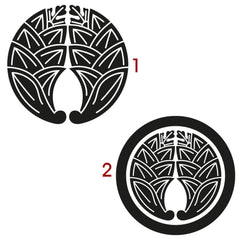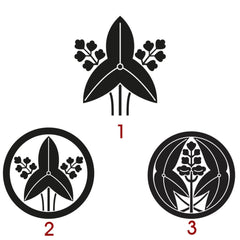Kiri Kamon Engraving
商品詳細・サイズ表
-
Kiri Kamon Engraving
Figure
Paulownia tomentosa (princesstree) - 「桐」 in Japanese
The Kiri is one of the 10 most used family emblems (judaimon) in Japan. Kiri were seen as sacred trees in ancient China, because it was believed that phoenixes only perched on their branches.
Due to these revered origins, the Kiri emblem was first adopted as the preferred mark of the Japanese imperial family during the Heian period (794-1185), and was later used by several samurai clans, most notably the Abe and the Ashikaga. Toyotomi Hideyoshi is also famous for having used at least 3 variations of the Kiri mon during his life.
There are about 280 known variations of the Kiri mon
Kamon 1
Go-shichi no Kiri (pauwlonia with 7 & 5 flowers).
The original and most esteemed Kiri mon. Although being a motif associated with Japan’s emperors, Kiri as a formal kamon was mostly used by samurai and warlords. The two first important clans to use a Go-shichi no Kiri mon were the Abe and the Ashikaga, but many more eventually used it throughout Japan’s history. The Go-shichi no Kiri is now the official emblem of the Japanese government.Kamon 2
Go-san no Kiri (pauwlonia with 5 & 3 flowers).
The Go-san no Kiri has been used by many throughout Japan’s history. However, having less flowers than the most revered Go-shichi no Kiri, it was somehow considered as a “lesser rank” mon.Kamon 3
Maru ni Go-san no Kiri (pauwlonia with 5 & 3 flowers in a ring).
The most commonly used Kiri variation nowadays.Kamon 4
Taiko-giri (the Regent’s pauwlonia).
Toyotomi Hideyoshi was a Kiri lover! He started to use the Go-san no Kiri mon when he was working as a henchman for Oda Nobunaga. After the untimely death of his master, Hideyoshi became the de facto ruler of Japan, and changed his emblem to the Go-shichi no Kiri mon. Being a prodigal lord, he gave away the right to use the Kiri emblems to many of his vassals, but since he wanted to have a mon for his exclusive use, he created the Taiko-giri, or “Regent” Kiri, a title he had received from the emperor.
How to Order - Service Description- Select Kamon design
-
Select Kamon size
1.5 cm fits on all weapons and is fairly small for a Kamon. We recommend this size only for Kamon with few details. Fits all weapons, including 24 mm Jo.
2 cm can be considered as standard. It fits on most weapons, except on the thinnest weapons such as the 24 mm Jo.
2.5 cm is fairly big and will not fit on thin Koryu Bokken, Tanto, Bo, Hanbo, and Jo.
If the selected size is too big for the ordered weapon, the Kamon will be adapted to the maximum engravable size. -
Select Kamon position
If you wish to offset the position in regard to a name engraving ordered from the product page, please use the "additional instructions" field. -
Additional instructions
If you order several weapons, please use the field "additional instructions" to specify which weapon should be engraved.
All special requests must be discussed prior to placing your order. If you have a doubt, email us before placing your order.
One Kamon = One engraving. For more than one engraving, add the Kamon as many time as desired with the correct options.
This is not a product but an engraving service that can only be ordered as part of a simultaneous purchase with a product on which to engrave. -
適用加工サービス
アクセサリー
本日のご注文の場合、以内の発送予定です。
本日のご注文の場合、以内の発送予定です。






















